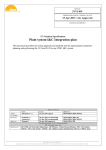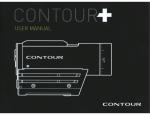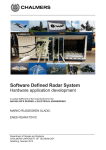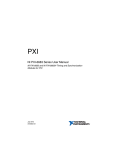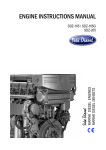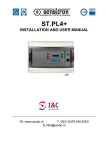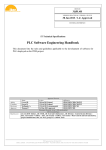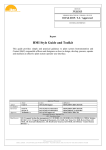Download CODAC Core System Version 4 Release Notes
Transcript
IDM UID DUHJ86 VERSION CREATED ON / VERSION / STATUS 03 Jul 2014 / 1.8 / Approved EXTERNAL REFERENCE User Manual CODAC Core System Version 4 Release Notes These are the release notes for the versions 4.x of the CODAC Core System distribution. Author Co-Authors Reviewers Approver Read Access Name Di Maio F. Approval Process Action 03 Jul 2014:signed Affiliation IO/DG/DIP/CHD/CSD/CDC Stepanov D. Park M. 04 Jul 2014:recommended IO/DG/DIP/CHD/CSD/CDC 04 Jul 2014:approved IO/DG/DIP/CHD/CSD/CDC Document Security: Internal Use RO: Stepanov Denis AD: ITER, AD: External Collaborators, AD: IO_Director-General, AD: IC_OMPE_WG, AD: Division Control System Division - EXT, AD: Section - CODAC - EXT, AD: Section - CODAC, AD: Auditors, AD: ITER Management Assessor, project administrator, RO PDF generated on 04 Jul 2014 DISCLAIMER : UNCONTROLLED WHEN PRINTED – PLEASE CHECK THE STATUS OF THE DOCUMENT IN IDM Change Log Title (Uid) Version Latest Status Issue Date Description of Change CODAC Core System Version 4 Release Notes (DUHJ86_v1_8) v1.8 Approved 03 Jul 2014 Updated for the 4.3.0 release: new features, new components, updated list of documentation and of know issues. CODAC Core System Version 4 Release Notes (DUHJ86_v1_7) v1.7 Approved 14 Feb 2014 Updated for the 4.2.0 release. CODAC Core System Version 4 Release Notes (DUHJ86_v1_6) v1.6 Approved 03 Jul 2013 Fixed the issue in last sentence + updated the version of this document in the document table. CODAC Core System Version 4 Release Notes (DUHJ86_v1_5) v1.5 Signed 03 Jul 2013 This is the final version for the 4.1.0 release. - minor text corrections - update of the documentation table - update of the known issues chapter from bug list CODAC Core System Version 4 Release Notes (DUHJ86_v1_4) v1.4 Approved 28 Jun 2013 Version before the release. CODAC Core System Version 4 Release Notes (DUHJ86_v1_3) v1.3 In Work 20 Jun 2013 Draft for preparation. To be replaced. CODAC Core System Version 4 Release Notes (DUHJ86_v1_2) v1.2 Approved 15 Feb 2013 Version for the release. CODAC Core System Version 4 Release Notes (DUHJ86_v1_1) v1.1 Signed 04 Feb 2013 Bug list should be OK. CODAC Core System Version 4 Release Notes (DUHJ86_v1_0) v1.0 Remains final text check, doc update & issues update. Text to finalize + doc table to update. In Work 01 Feb 2013 PDF generated on 04 Jul 2014 DISCLAIMER : UNCONTROLLED WHEN PRINTED – PLEASE CHECK THE STATUS OF THE DOCUMENT IN IDM Contents 1 INTRODUCTION...................................................................................................................3 2 NEW FEATURES AND CHANGES IN 4.X (4.0-4.3) .........................................................4 2.1 System changes ..................................................................................................................4 2.2 TCN support ......................................................................................................................4 2.3 SDN support.......................................................................................................................4 2.4 DAN support ......................................................................................................................5 2.5 Maven commands ..............................................................................................................5 2.6 Maven Editor .....................................................................................................................6 2.7 PLC integration .................................................................................................................8 2.8 SDD .....................................................................................................................................9 2.8.1 COS-PSOS support........................................................................................................9 2.8.2 Cubicle monitoring ......................................................................................................10 2.8.3 Common Excel and csv format between Editor and webapp ......................................11 2.8.4 Breakpoints table .........................................................................................................11 2.8.5 Migration of templates .................................................................................................12 2.8.6 SDD Editor...................................................................................................................13 2.8.7 SDD Web application ..................................................................................................14 2.8.8 SDD migration .............................................................................................................16 2.8.9 Other new SDD features ..............................................................................................16 2.9 Control System Studio.....................................................................................................16 2.9.1 On-line help (v4.1).......................................................................................................17 2.9.2 CaSnooper....................................................................................................................18 2.9.3 PV Fields viewer..........................................................................................................19 2.9.4 PACE Editor ................................................................................................................19 2.9.5 Web OPI.......................................................................................................................20 2.9.6 Web Data Browser .......................................................................................................20 2.9.7 Web Alarm Interface (v4.1) .........................................................................................21 2.9.8 Alarm Web Reporting Tool (4.2).................................................................................21 2.9.9 PV Name Lookup (v4.1)..............................................................................................22 2.9.10 ELog - Electronic Logbook (v4.1)...............................................................................23 2.9.11 Archive Web Reporting Tool (4.2) ..............................................................................24 2.9.12 PV Manager Probe (4.2) ..............................................................................................24 2.9.13 Automation of Sequence of commands (4.2) ..............................................................25 2.9.14 Plot Show value labels function...................................................................................26 2.9.15 BOY enhancements .....................................................................................................26 2.9.16 BEAST enhancements .................................................................................................31 2.10 I/O support .......................................................................................................................32 2.10.1 Timing boards ..............................................................................................................32 2.10.2 NI PXI-6259.................................................................................................................32 2.10.3 NI PXI-6528.................................................................................................................32 2.10.4 NI RIO (from 4.2) ........................................................................................................33 2.10.5 NI PXIe-6368 (from 4.3) .............................................................................................33 2.11 Samples .............................................................................................................................33 3 KNOWN ISSUES ..................................................................................................................34 Page 1 of 37 3.1 3.2 3.3 3.4 4 Known issues in version 4.0.0 .........................................................................................34 Known issues in version 4.1.0 .........................................................................................34 Known issues in version 4.2.0 .........................................................................................35 Known issues in version 4.3.0 .........................................................................................35 USER DOCUMENTATION ................................................................................................37 Page 2 of 37 1 INTRODUCTION This note is a supplementary document for the CODAC Core System (CCS) that applies to the 4.0 major version and to any derived minor releases. It introduces the main new features and changes with respect to the previous releases (3.0 and 3.1). It will be updated to describe the features and changes introduced with the minor release(s) and the bug fixes distributed via the maintenance release(s), if any. This version of the document has been produced for the release of the 4.3.0 version. This document is complemented with the exhaustive list of changes, enhancements and bug fixes introduced in each official releases. References: [RD1] Changes in 4.0.0 from Bugzilla (HTLSJS) [RD2] Changes in 4.1.0 from Bugzilla (HTNBUB) [RD3] Changes in 4.2.0 from Bugzilla (LYJDMG) [RD4] Changes in 4.3.0 from Bugzilla (PJPQSV) Page 3 of 37 2 NEW FEATURES AND CHANGES IN 4.X (4.0-4.3) Note: Features and changes that have been introduced after the release of the version 4.0.0 are indicated with the version from which they are present. 2.1 System changes The 4.x versions are based on RHEL 6.3. RHEL MRG-R 2.1 (kernel 3.0) is optionally available for fast controllers, in case high determinism is required. The latest releases (3.14.12.3) of the EPICS 3.14 base have been included: 3.14.12.3 with v4.0 and v4.1 and 3.14.12.4 with CCS v4.2. The new minor release of the RHEL does not require the re-installation of the existing CCS v3.0 or higher development or target systems but they will receive an operating system upgrade together with CCS v4.0. Still, it is recommended whenever possible to re-install the development systems with new versions instead of upgrading an existing installation to avoid the coexistence of multiple versions where that is not explicitly required. 2.2 TCN support The TCN daemon (TCNd) shall replace NTPd on TCN connected systems for synchronizing the system time with ITER time. This component is part of the distribution since 3.0. The TCN library (TCN API) is providing programmers with synchronization functions (wait, register callback) using the ITER time, distributed via TCN. From version 4.3 TCNd has been heavily reworked to improve performance and robustness, the accuracy of system time on fast controllers synchronized via TCN is demonstrated to be less than 1 µs Furthermore, TCNd performance metrics are monitored at runtime and available to implement failure detection and investigation The TCN API has been rewritten for operating on different TCN interfaces and for being fully compliant with multi-CPU hosts Documentation for TCNd and TCN API have been added in the distribution.. 2.3 SDN support The Application Programing Interface (API) for the Synchronous Databus Network (SDN) has been included in version 4.0 with the associated libraries and tools. The SDN API allows software programs distributed over Fast Controllers and HighPerformance Computers to exchange data over SDN with guaranteed performance. The API is implemented as a C++ library. This library operates with the selected SDN media, i.e. Ethernet. The library functions on any Ethernet port; yet, the performance requirements are only achieved through use of compliant boards and switches. The main features are the following: Page 4 of 37 - Configuration of the messages, identified as topics, i.e. named logical communication channels, exchanged over the SDN network. Provision of C++ classes implementing the communication following an anonymous publish-subscribe pattern, and isolating the calling programs from any deployment and technological considerations. Generation of the C++ header files for topics data type definition and topic-specific communication classes for each participant role. Implementation of performance and health assessment features transparently to the calling application. Discovery and monitoring of the connected nodes and of the data exchange by an external dedicated program (v4.1) to support fault and failure detection and isolation. Distribution of critical messages, i.e. event topics, with acknowledgment from receiver and timeout detection. (v4.1). Participating programs can publish and subscribe to multiple topics; multi-threading is also fully supported. From version 4.1 The configuration is done with SDD tools: declaration of the SDN topics data types and SDN programs, and association between topics and programs. From version 4.2 Subscriber nodes can receive data synchronously over multiple topics in one blocking API call The API has been further simplified to make it more user-friendly The interaction between SDN participants and the optional monitoring node has been made more robust. From version 4.3 The skeleton and configuration of the SDN applications from SDD toolkit has been revised The API has been further simplified from user feedback, i.e. the behavior of the library has been made more robust to typical configuration errors, The documentation has been extended with simpler example code Remark: The draft SDN API that has been distributed in previous versions, up to v3.1, is now deprecated and will cease to exist with v5.0. 2.4 DAN support From v4.2, a draft version of the DAN API and of the associated services for development and tests is included in the distribution. It implements the basic features for DAN data archiving. These components are under development and not yet stable. The CODAC support can be contacted for information and details. From v4.3, the API has been extended to support metadata. It is still a draft API. Documentation has been included in the distribution. 2.5 Maven commands From version 4.0: Page 5 of 37 C++ programs have been added into I&C projects. A newprog command allows adding programs developed in C++ or C. The other commands for building, testing, packaging and installing the application code have been extended to include C/C++ programs. The inclusion of SNL programs in IOC process is now automated by the compile command so build files edition is not anymore required. Configuring archiving and alarm handling can be done by means of dedicated commands: beauty and beast. From version 4.1: Support for SDN programs has been introduced From version 4.2: IOCs as well as C/C++ programs can be tested on target hosts different than the development system on which they are built. The run, status, stop and connect commands have been extended with a remote option to execute the command on the indicated remote host. A readlog command has been added to allow reading IOCs and programs logs on the remote hosts on which these processes are running. The remote option is also supported by the beauty and beast commands allowing the activation of archiving and alarm handling on remote servers. 2.6 Maven Editor A component has been added in v4.0 to provide the user with graphical interfaces for building, testing and packaging applications. This component can be used as a stand-alone tool or from the SDD editor, as a dedicated view. This component allows the execution of all the steps for building and testing the application with a graphical user interface. When using the SDD editor, this is integrated in the same tool. The following actions are implemented: - Generate the configuration files Clean, compile, run (one click) Connect to an EPICS console Get status of the project’s IOCs Import the configuration files for alarms (BEAST) and archives (BEAUTY) activate these (restart option) Create a new epics app, and reassign IOCs Monitor the execution of the commands in the console view. and A Maven Editor view in SDD editor replaces the File Navigation view and allows the execution of the Maven commands from pop-up menus associated with the software unit. Page 6 of 37 Additions in v4.1: Integration of BOY editor: now you can create, develop and launch BOY HMIs from maven editor. It allows a faster development cycle. Integration of SNL compiler : now when saving a SNL file, it actually triggers SNL compilation: the behaviour is the same as one as in SNL editor; Starting IOC in debug mode : now you can start IOC in debug mode; Integration of mvn retrofit and mvn commands related with SVN (checkout, update, generate) Integration of C/C++ editors to allow C/C++ development for SDN applications Performance improvement of mvn compile Addition in 4.2 Support of remote execution: EPICS IOCs and C/C++ programs can be started on target hosts different from the Mini-CODAC system that is used for SDD configuration. The target hosts are either the control units that are defined in the SDD configuration or some test systems selected by the user. This allows testing the application on remote Page 7 of 37 hosts with the appropriate hardware configuration. The checkout command now saves a copy in the SDD database if none was existing. Addition in 4.3 2.7 Multiple projects unload. Integration of a Python editor and RPM archive explorer. Tree view refactoring (SVN metadata, informative icons, …). Remote logs synchronization. Remote host registration. Synchronization with SDD Central database in case of SVN commits. Improve edition features (copy/cut/paste operations on files, file import, …). PLC integration From v4.0: The support for redundant configuration (ex: interlock PLCs) has been introduced in the driver to allow the PSH to communicate with the active CPU and switch to the other one in case of a fail-over. The handling of abnormal communications has been improved. The PLC data blocks can be ordered by data type (a new option in SDD) to allow more compact network packets. From v4.1: The SDD toolkit (editor and webapp) now supports the configuration of redundant PLCs with two IP names and the Translator generates the proper initialization for redundant PLCs. Page 8 of 37 Figure 1 - Redundant PLC edition The Standard PLC Software Structure (SPSS) has been updated to allow communication with either the CPU or the Communication Processor of a PLC. From v4.3: Backward compatibility is supported by allowing interoperability of PSH and PLC software built with different version of the CCS distribution 2.8 SDD 2.8.1 COS-PSOS support Common Operating State (COS) and Plant System Operating State (PSOS) are part of the standard interface each plant system I&C should implement. COS is generic (unique definition for all plant systems). PSOS is plant system specific. The SDD tools now support the implementation of the standard COS variables: <CBS1><CBS2>:COS-OPSTATE and <CBS1>-<CBS2>:COS-OPREQ, as defined in the PCDH. The editors allow creating a mapping table between the generic values of the COS variables and the plant system specific ones of the PSOS variables. Predefined mapping tables illustrating different category of plant systems can also be copied and edited. Page 9 of 37 For COS variables implementation, the translator generates: The SNL program that implements the COS state machine in the PSH. The PSOS variables in the selected controller. A BOY HMI for interacting with the COS state machine. 2.8.2 Cubicle monitoring The cubicles that are part of an I&C installation can now be declared in the project and the cubicle environment variables (temperature, door status…), implemented in a dedicated PLC, monitored from a PSH. Page 10 of 37 For cubicles, the translator generates: - The PVs that implements the cubicle state in the PSH. A BOY HMI for visualizing the cubicles state. 2.8.3 Common Excel and csv format between Editor and webapp From v4.2 Now Editor and Webapp support the same Excel format for component and signals, control units and variables. It also share common CSV format for importing several instances of templates. 2.8.4 Breakpoints table From v4.0 Support for EPICS breakpoint tables both in Editor and webapp: import your breakpoint table and it will appear in the LINR menuc choice of your PV if applicable Page 11 of 37 Figure 2 - Breakpoint table edition 2.8.5 Migration of templates From v4.2 The SDD Editor and Webapp offer a function to cope with changes made in the EPICS templates, either system templates (ex: PXI-6259 board) or user-defined ones. Conversion features allow updating the variables that have been instantiated with a template that has been modified. Page 12 of 37 2.8.6 SDD Editor From v4.0: The editor is now loading and saving data from/to the DB automatically, the explicit “Save to DB “have been suppressed. The “lazy loading” behavior has been implemented: data is retrieved when displayed/edited and saved back transparently. A debug view with PV links and dynamic value display and control has been added. The support for system templates (CODAC templates) and user-defined templates has been improved with a dedicated view (the Template view). The support for the timing board has been completed with templates for boards and terminals. From v4.1: Editor now supports the selection of asyn reason for I/O boards as in the web application Page 13 of 37 Editor supports deletion of single user template instance From v4.2: Support of import/export XML: projects can be saved and loaded from/to XML files from the editor. Support of cubicles and chassis From v4.3 Support for user macros when defining new User Templates; New Template view to list the templates instanciated per I&C project Support of X-series boards (PXIe-6368) 2.8.7 SDD Web application From v4.0: A Location view allows visualization and navigation using the physical layout (cubicles/chassis/controller/board) Page 14 of 37 A wizard for I&C project declaration guides the user and reduces navigation. The search/query have been improved The central repository can now be accessed. From v4.1: Support for import/export of XML for selected topics: very useful to share and exchange topics between local and central database From v4.2 Check that all PVs are properly connected Page 15 of 37 From v4.3 Support for user macros when defining new User Templates; New Template view to list the templates instanciated per I&C project Support of X-series boards (PXIe-6368) SDN topic neighbourhood view 2.8.8 SDD migration From v4.0: The SDD migration tool on version 4.0 allows transferring the I&C projects in the local SDD database when a development system is upgraded from version 3 to version 4. From v4.1: The SDD migration tool on version 4.1 allows transferring the I&C projects in the local SDD database when a development system is upgraded from version 3 to version 4.1. Upgrade from 4.0 to 4.1 is also supported 2.8.9 Other new SDD features From v4.1: Support for redundant PLCs both in editor and webapp Support for SDN both in editor and webapp Support for merging two I&C projects both in webapp and editor to alllow merging separate deliverables for the same plant system I&C or importing/exporting SDN topics shared by different teams. Support for declaring network interfaces and mac address on control unit level; Support for declaring variables coming from interlock; 2.9 Control System Studio From v4.2, ITER Control System Studio default perspective has been replaced by CSStudio perspective. If you are using an existing workspace, it is recommended to switch to the new Page 16 of 37 default one via the menu Window -> Open Perspective -> Other and then select . From v4.3: CS-STUDIO 3.3.0 is integrated. The EPICS Channel Access JAVA library version is CAJ 1.1.14 ITER CS-STUDIO products command line can provide the version number via the option –version or –help $ css –version css 3.3.0.codac_core_4_3_0 2.9.1 On-line help (v4.1) ITER CSS Getting Started section on the online Help: CSS Changelog – new ITER CSS section that lists the main newly integrated enhancements and bug fixes Page 17 of 37 ITER CSS Tutorials – the exercises are also demonstrated during CSS training sessions: 2.9.2 CaSnooper The CaSnooper is a simple program to display statistics of EPICS broadcasts on the network Page 18 of 37 2.9.3 PV Fields viewer The PV Fields viewer is a diagnostic tool to display information about a Process Variable. By default it displays information obtained by connecting to the life control system channel, which includes the name of the host that serves the channel, the underlying data type etc. ITER Site-specific extensions include information from EPICS db files about the original value of fields, the record type and more. 2.9.4 PACE Editor The PACE editor provides a tabular view of Process Variables (PV) names and their current values. The user can edit the values, change multiple values at once, review the changes and revert them if needed Page 19 of 37 2.9.5 Web OPI Web OPI aims at providing web access to Operator Interfaces (OPI) that were created in CSS BOY. With WebOPI, the user can seamlessly access to their OPIs from anywhere in the world at any time via a web-browser-equipped device such as a PC, laptop, tablet or smart phone: 2.9.6 Web Data Browser With the Web Data Browser, It is now possible to access plotted data from a Web Navigator From v4.1, the Search view is hidden by default. The vertical and horizontal zoom cursors have different shapes Page 20 of 37 2.9.7 Web Alarm Interface (v4.1) 2.9.8 Alarm Web Reporting Tool (4.2) The online reporting tool – http://localhost:8080/alarm-reporting/ – allows you to check what are the active alarms? What are the stale alarms? And what is the top 10 alarms? Page 21 of 37 2.9.9 PV Name Lookup (v4.1) Auto completion based on History and DB files parsing. Example of auto completion in BOY Editor in the PV Name field of a PV widget: From v4.2: You can get some help entering loc, sim and sys PV Page 22 of 37 2.9.10 ELog - Electronic Logbook (v4.1) Logbook with automatic content from OPI, plot and alarm views. Example of the creation of a log entry from an OPI: From v4.2: Web Interface to the Electronic Logbook – http:// http://localhost:8080/elog - another way to create and search for entry From v4.3: A triggered alarm can create an electronic logbook entry automatically via a pre-configured automated action Logbook entries can be mapped to a URL so that they can be copied into emails, other log entries, etc. Page 23 of 37 Logbook search table refreshed automatically with new entries when the view is active. 2.9.11 Archive Web Reporting Tool (4.2) The online reporting tool - http://localhost:8080/archive-reporting/ - shows you how many PVs are archived and can extract for instance the last 50 samples of an archived PV. 2.9.12 PV Manager Probe (4.2) This new Probe tool dedicated to PV Manager access layer provides detailed information on the PV and allows you to copy the value to the clipboard. Page 24 of 37 2.9.13 Automation of Sequence of commands (4.2) From v4.2, CSS integrates a Scan Editor Perspective that allows you to edit interactively a sequence of commands, simulate it, submit it for execution and monitor it. Page 25 of 37 ITER CSS also supports PyDev - Jython Editor and Debugger Support for Python scripts. 2.9.14 Plot Show value labels function In the plot toolbar, a new icon mouse over the plot. Just try it! allows you to show the PV value when you mouse the 2.9.15 BOY enhancements From v4.0: Page 26 of 37 Image widget rotation by 90 degrees: Data Browser widget that allows to integrate a predefined plot .plt file into BOY and then access to historic data: Vertical Tabbed Container and possibility to enable/disable tab according to operational states: Page 27 of 37 Support of waveform and setpoint via an Array Widget that allows to adjust the setpoint using sliders for example A PID example is provided at /opt/codac/opi/boy/resources/PID_Water_Cooling.opi It is now possible to open OPI file directly from command line css <unit_name>/src/main/boy/myScreen.opi From v4.1: Addition of a small square handle on top left of PV widget to allow editing PV Name directly on widget. Hover mouse on the handle will show PV Name as tooltip. Handle color could be grey or orange, depending on if the PV name is empty or not Addition of a feedback to Grouping Container widget showing if it is locked. Click the handle can lock/unlock the container Page 28 of 37 Change of the looking and colours of Check Box and Radio Box to have modern style and feeling Dump PV List context menu in Runtime to dump all PVs in the OPI including the ones for rules and scripts Top OPIs menu allows now to open directly plot files: From v4.2: New ITER CSS OPI Probe that displays more details regarding a Digital and Analog PV (alarm thresholds, engineering units…) CSS/Display/OPI Examples have been moved to CSS/Utilities/Install Samples menu Add Open Navigator context menu entry to OPI Runtime to open Navigator View Page 29 of 37 Add OPI Editor Perspective context menu entry to OPI editor to open/reset OPI Editor Perspective Add OPI Runtime Perspective context menu entry to OPI Runtime to open/reset OPI Runtime Perspective New Fluid symbols for CRYO and CWS – in particular 3 positions valve symbols – closed, opened and partially opened From v4.3: BOY Graphics Image Widget handles now SVG images BOY Symbol Widgets handle 'ForeColor Alarm Sensitive' property OPEN state triggers a MAJOR, MINOR, INVALID alarm Foreground Alarm Sensitive Page 30 of 37 BOY Symbol Widgets have a new preference to specify which colour code has to be replaced at runtime by the On/Off colour. By default, the black colour is replaced 2.9.16 BEAST enhancements From v4.0: The Alarm Annunciator tool converts the alarm description into speech. From v4.2: Message History auto-refresh every 30 seconds: The CSS -> Alarm -> Message History view is now automatically refresh every 30 seconds. You can change this preference: Edit -> Preferences -> CSS Applications -> Alarm -> Message History -> Auto refresh period [seconds]. Page 31 of 37 2.10 I/O support 2.10.1 Timing boards From v4.1: The timing boards support software has been updated to support the new board from NI. The model name is PXI-6683H. The users of this new board should contact the CODAC support to obtain an update of the Linux driver for using it. The Linux driver for timing boards has been replaced by a new one that not only support new boards but that also resolves some existing issues (see the list of changes [RD2]). This driver however requires the firmware of the board (FPGA revision) to be at a minimum level: 09031718 (YYMMDDHH). The user documentation has been updated for covering the new board and for clarifying the different time references used in the software (TAI vs. UTC). From v4.2: Add function for upgrading the board firmware (6682 and 6683) on demand Allow reading the number of pending FTEs for any selected terminal Conversion from epoch time to human time in the EPICS interface From v4.3: Improve AO (new firmware for fixing an issue with DAC voltage) Add the capacity of changing clock frequency on PXI-6683H stopping/restarting (new firmware). Improve HW FIFO detection Add the reset function in the EPICS interface Reduce the delay for immediate FTE and extend the overrun detection without 2.10.2 NI PXI-6259 From v4.1: Support for the finite acquisition mode from EPICS Addition of the EPICS interface for counters Correction of errors for the AI differential mode handling From v4.2: Supporting DMA data transferring AI/AO Pause triggering is available Routing signals to PFI terminals is possible PFI direction can be changed during run time Calibration API is provided. Counter can detect Rising or Falling Edge 2.10.3 NI PXI-6528 Extension of the EPICS interface (in existing templates) with PVs for the board status and for various configurations: digital filter, signals routing, change detection options, watchdog configuration. Page 32 of 37 EPICS interface to individual signals with bi/bo records. I/O scan mode support in EPICS interface on level detection 2.10.4 NI RIO (from 4.2) Linux library for NI FlexRIO PXIe-796xR bundles 7966R/5791R ADC, 7961R/6581 DIO and 7966R/1483 Image Acquisition. Implements configuration, register level communication and data transfer between the host controller and the FPGA on the FlexRIO device. Downward compatible and performance wise matching with the proprietary binary version. 2.10.5 NI PXIe-6368 (from 4.3) Kernel mode driver and user libraries for the PXIe-6368 (fast multipurpose DAQ) EPICS interface 2.11 Samples I&C application examples simulating some piece of equipment, such as: ICH sample, fast controller sample and health monitoring sample, have been suppressed from the CODAC Core System distribution. Such examples are now made available for download at the following address https://portal.iter.org/IPT/IC-IPT/Pages/IandC-Use-Cases.aspx These will be updated independently from the CODAC Core System distribution. Page 33 of 37 3 KNOWN ISSUES 3.1 Known issues in version 4.0.0 The following ones are useful to know: 1. Some bug are remaining in the timing boards software: 3438 nisync driver may lock up after FIFO overflow 3473 PXI6682 FPGA reset may fail 3135 PXI6682 - Immediate events delay is out of specification: more than 1 microsecond 3602 PXI6682 - Clock frequency accuracy on PXI-TRIG lines does not comply with specifications (50 ns) 3199 Some 3.0 examples are missing for the nisync user library. (not relevant anymore) 2. 3. 4. 5. 6. 7. 8. A new version of the driver is planned for 4.1 Triggered analog output with PXI-6259 cannot be reloaded (bug 3184). The PXI-6259 analog input range -2V/+2V does not work correctly. (bug 3897) Tomcat may not be initialized correctly after a reboot (bug 3070). This is documented in the troubleshooting section of the web app documentation. Writing values to a PLC outside the supported range for the data type is not correctly handled (bugs 3858, 3859, 3860, 3861). But this does not occur when the limits (HOPR, LOPR) are properly set. One more bug (3895) has been discovered after the release that prevents communication with more than one PLC from the same PSH. A major issue in the SDD parser is preventing retrofitting modified db files (bug 4061). The TCN daemon that sets the time on fast controllers from a timing board is using TAI instead of UTC. As a result, the time is wrong by 35 s (bug 4463). Except for performance issues (3135 and 3602), all these issues have been resolved in v4.1.0. 3.2 Known issues in version 4.1.0 At the time of the release, the following significant issues haven’t been resolved: bug_id 3543 3953 4435 component PXI-6259 NI Sync Driver Drivers short_desc Introduce direct DMA buffer access to user space code for 6259 ni-sync drivers doesn't get the UTC time Values set in output records at intialisation (VAL filed set from SDD) are ignored - all templates. The consequences of these issues are: 1) The performances of the PXI-6259 for acquiring many signals is limited because the context switches. 2) Timing boards are using TAI time instead of UTC time (35 seconds difference as of today). This may change. Anyway, some conversion functions will be required. 3) Setting the VAL field in EPICS PV from SDD editor for configuring the PXI-6682 board doesn’t work. IOC functions or setting PVs after IOC initialization should be used instead. Page 34 of 37 3.3 Known issues in version 4.2.0 The following is the list of known issues at the time of the 4.2.0 release. Please contact the CODAC support for details. None is qualified as a major issue with respect to usage. bug_id component Description 5293 CSS BEAU Databrowser plot Time Axis Auto Format issue 5278 CSS BOY Plot Databrowser widget in WebOPI does not show value labels 2982 EPICS Base org.csstudio.platform.libs.epics/use_pure_java=false generates WARNINGS 4346 NI Sync Terminal status does not reflect the HW FIFO Overflow (TP-NSA-3032) 4442 NI Sync Decimation count problem (TP-NSA-3023) 4916 NI Sync Get board time delay less that 10μs instead of 1us 4630 NI Sync TCN library does not work on multi-socket configuration. 5202 NI SYNC PTPd does not support time past the beginning of 2038 2933 Packagin EPICS IOC should not bind themselves to the TCN interface for CA 5107 PXI-6259 AO FIFO re-transmitted mode failure depending on the number of samples. 5128 PXI-6259 [EPICS] During PXI-6259 ioc long-term test, AI value was not updated on the 3rd day. 3837 SDD Data plc datablock version does not get updated in case of template variables modif 3657 SDD Tran sdd-translator consumes too much CPU even for small projects 4449 SDN API IC unit cannot be compiled with multi arrays for SDN variable meta-data Detailed performances results are also available on request. 3.4 Known issues in version 4.3.0 The following is the list of known issues at the time of the 4.3.0 release. Please contact the CODAC support for details. None is qualified as a major issue with respect to usage. bug_id component Description 5278 CSS BOY Plot Databrowser widget in WebOPI does not show value labels 3135 NI Sync Immediate events delay is out of specification: more than 1 microsecond 3602 NI Sync Clock frequency accuracy on PXI-TRIG lines does not comply with specifications (50 ns) 3891 NI Sync Nisync Test TP-NSA-3014: FTE accuracy on PXI-TRIG exceed specifications (20 ns) 4442 NI Sync Decimation count problem (TP-NSA-3023) 5202 NI SYNC PTPd does not support time past the beginning of 2038 2933[SEC] Packagin EPICS IOC should not bind themselves to the TCN interface for CA Page 35 of 37 5818 Packagin ioc screen log files shall also be included in logrotate 5107 PXI-6259 AO FIFO re-transmitted mode failure depending on the number of samples. 4897 S7 EPICS First simple command after PLC restart fails 3837 SDD Data plc datablock version does not get updated in case of template variables modif 5846 SDD Data Migrating nisync terminal template from 410 to 430 fails 3657 SDD Tran sdd-translator consumes too much CPU even for small projects 5454 SDD Tran PLC generated files 4449 SDN API IC unit cannot be compiled with multi arrays for SDN variable metadata Detailed performances results are also available on request. Page 36 of 37 4 USER DOCUMENTATION The following list of documents composes the user documentation. All the documents are included in the distribution and in IDM. Document OVERVIEW CODAC Core System Overview CODAC Core System User Manual INSTALLATION & SUPPORT CODAC Core System Installation Manual CODAC Core System Migration Manual CODAC Core System v4 Release Notes DEVELOPMENT & TESTING CODAC Core System App Developer's Manual SDD Editor User Manual SDD Web Application User's Guide SDD Synchronization Guide How to include a new I/O module in SDD Maven Editor User Guide OPI - CSS BOY Edition & Runtime OPI - CSS BOY Symbol Library SLOW CONTROLLERS (PLC) SPSS User Manual S7 PLC EPICS Driver Extensions PLC Sample Guide FAST CONTROLLERS - I/O NI Sync Linux Device Driver User's Guide NI Sync EPICS Driver User's Guide NI PXI-6259 Linux Driver User's Guide NI PXI-6259 EPICS Driver User's Guide NI PXI-6528 Linux Driver User's Guide NI PXI-6528 EPICS Driver User's Guide NI X-Series Linux Device Driver User's Guide NI X-Series EPICS Driver User's Guide NI-RIO Linux Device Driver User Manual NDS User Manual FAST CONTROLERS - HPN TCN library - Software User Manual TCNd User Manual SDN Software User Manual DAN API Reference Document Presentations for training CODAC Core System Overview CSS all in one ID 4.0 4.1 4.2 4.3 34SDZ5 43PSH9 v4.0 v3.0 v4.1 v3.1 v4.2 v3.2 v4.3 v3.3 33JNKW 7JCFUD DUHJ86 v4.2 v3.2 v1.2 v4.4 v3.5 v1.6 v4.6 v3.7 v1.7 v4.8 v3.8 v1.8 33T8LW 32Z4W2 42NFCY 46AAXR A4WQDZ 7MT2YC 7367JQ A69URK v4.2 v6.1 v4.3 v1.10 v1.0 v1.2 v1.2 v4.4 v7.1 v5.1 v1.11 v2.1 v1.3 v1.2 v4.5 v7.3 v6.2 v1.11 v3.1 v1.3 v1.2 v4.6 v7.4 v7.0 v1.12 v2.0 v4.2 v1.4 v1.3 G4UMX5 6KFJEJ 2N8C3M v1.0 v3.0 v1.0 v3.1 v1.2 v2.0 v3.1 v1.3 v2.0 v3.1 2PLQ4P 33Q5TX 32GTJY 3DEY52 3ZHXQ9 433VEW 3LTMR6 3P4N3R LW3UFH A6LWQ8 v1.15 v2.3 v1.16 v2.1 v1.7 v1.5 - v2.1 v2.3 v1.16 v2.2 v1.7 v1.7 - v2.2 v2.4 v1.17 v2.5 v1.7 v1.10 v1.3 v1.2 v2.4 v2.7 v1.17 v2.6 v1.7 v1.10 v1.3 v1.3 v1.5 v1.2 N4XTGG MUYNT6 B7SKFU LA5QWP V 1.5 - V 1.9 - v1.12 - v1.2 v1.2 v1.17 v1.3 97W6QN BFGP5Q v2.0 v1.2 v2.0 v1.3 v2.1 v1.5 v2.4 v1.6 Page 37 of 37











































